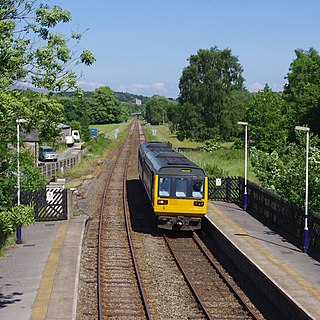
The Lancaster Canal is a canal in North West England, originally planned to run from Westhoughton in Lancashire to Kendal in south Cumbria. The section around the crossing of the River Ribble was never completed, and much of the southern end leased to the Leeds and Liverpool Canal, of which it is now generally considered part.

The Furness Railway (Furness) was a railway company operating in the Furness area of Lancashire in North West England.

The Caledonian Railway (CR) was a major Scottish railway company. It was formed in the early 19th century with the objective of forming a link between English railways and Glasgow. It progressively extended its network and reached Edinburgh and Aberdeen, with a dense network of branch lines in the area surrounding Glasgow. It was absorbed into the London, Midland and Scottish Railway in 1923. Many of its principal routes are still used, and the original main line between Carlisle and Glasgow is in use as part of the West Coast Main Line railway.
The North Western Railway (NWR) was an early British railway company in the north-west of England. It was commonly known as the "Little" North Western Railway, to distinguish it from the larger London and North Western Railway (LNWR).

The Lancaster and Carlisle Railway was a main line railway opened between those cities in 1846. With its Scottish counterpart, the Caledonian Railway, the Company launched the first continuous railway connection between the English railway network and the emerging network in central Scotland. The selection of its route was controversial, and strong arguments were put forward in favour of alternatives, in some cases avoiding the steep gradients, or connecting more population centres. Generating financial support for such a long railway was a challenge, and induced the engineer Joseph Locke to make a last-minute change to the route: in the interests of economy and speed of construction, he eliminated a summit tunnel at the expense of steeper gradients.
The Kendal and Windermere Railway built a branch line from the main line to Kendal and on to Windermere, in Cumbria in north-west England. It was promoted by local interests in Kendal when it became clear that the Lancaster and Carlisle Railway would not be routed through Kendal. It was built from a junction at Oxenholme to Kendal to a terminus near Windermere; at the time there was no settlement of that name. The line opened in April 1847. The engineer was Joseph Locke and the partnership of contractors consisted of Thomas Brassey, William Mackenzie, Robert Stephenson and George Heald.

The Cumbrian Coast line is a rail route in North West England, running from Carlisle to Barrow-in-Furness via Workington and Whitehaven. The line forms part of Network Rail route NW 4033, which continues via Ulverston and Grange-over-Sands to Carnforth, where it connects with the West Coast Main Line.

Arnside is a railway station on the Furness Line, which runs between Barrow-in-Furness and Lancaster. The station, situated 12+1⁄4 miles (20 km) north-west of Lancaster, serves the village of Arnside in Cumbria. It is owned by Network Rail and managed by Northern Trains.

The Hincaster branch was a single-track railway branch line of the Furness Railway which ran from Arnside on the Furness main line to a junction with the Lancaster and Carlisle Railway at Hincaster. Intermediate stations were provided at Sandside and Heversham, with the main engineering work being a substantial 26-arch viaduct over the River Bela near Sandside.
The Leeds and Bradford Railway Company (L&BR) opened a railway line between the towns on 1 July 1846. It extended its line from Shipley through Keighley to Skipton and Colne, in 1847 and 1848.

Coniston railway station was the northern terminus of the Coniston branch line in the village of Coniston, Lancashire, England.
Events from the year 1846 in the United Kingdom. This year is noted for the repeal of the Corn Laws.

The Leeds–Morecambe line, also known as the Bentham line, is a railway line running between Leeds, Skipton, Lancaster and Morecambe in northern England. The service is operated by Northern. The route covered by the service was historically part of the Midland Railway. The line is electrified at 25 kV AC overhead between Leeds City and Skipton- this section is known as the Airedale line.

Boar's Head railway station served the southern part of the village of Standish.
Symington railway station served the village of Symington in Scotland between 1848 and 1965. It was on the main line of the Caledonian Railway and for most of its life was the junction for the branch to Peebles.
Eskmeals is a former railway station in the Eskmeals area of the Cumbrian coast, England. It was located on the Cumbrian Coast Line, south of Ravenglass and near to the estuary of the River Esk. It was situated at the southern end of Eskmeals Viaduct. It served a scattered farming community.











